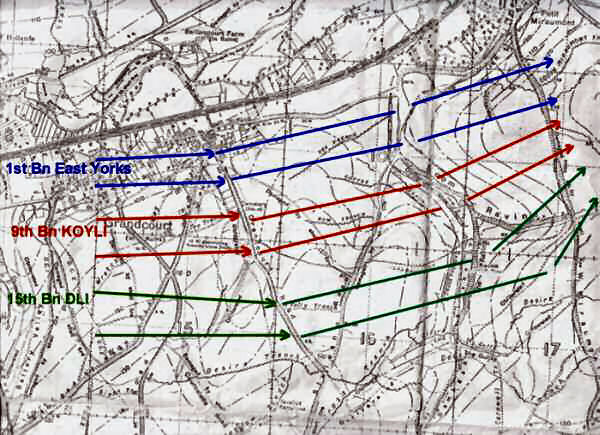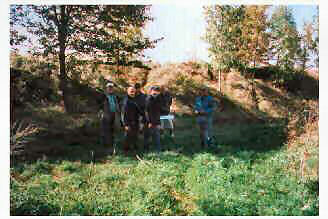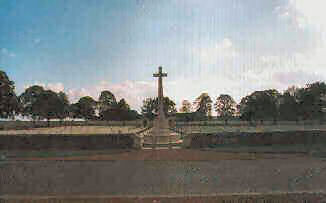
3498x2538 1.71MB
A Day on the Somme
Retracing Albert's last few yards
15th Bn. Durham Light Infantry
24th August 1918
On a sunny day in early October 2001, we journeyed down to the
Somme again to retrace the last footsteps of Albert Barker's short life.
Steve & Jon, along with their Father Tom, Chris, Ian, Jim and myself
squeezed ourselves into the Espace and headed down to the tunnel. We expected
to see the place bristling with security after the shocking events in New York
the previous month. Alas, we saw no evidence of heightened security, which does
not mean of course, that there was none, but it would have been reassuring to
see the odd machine gun wealding policeman or soldier. Anyway I digress. We
boarded the 06:21 to France and we studied the trench maps I had purchased from
the WFA. We knew Albert's Battalion, the 15th Durham Light Infantry had crossed
the Ancre near Grandcourt and we planned to follow his course from there.
We stopped in Arras for breakfast. It has a beautiful main square
and you can still see evidence of the damage to buildings, although it has been
completely restored to its pre war elegance. Ian and Chris were Battlefield novices
and we didn't want to bore them with our enthusiasm! We planned to break the day up.
The morning would consist of our walk over the battlefield near Miraumont and in the
afternoon, we would visit a museum to give them an insight into the war etc. Well it
happens from time to time! We got lost! We have done this trip countless times, but
on this occasion we took a wrong turn and ended up in Flers. You would have to ask
the driver how, but we did!
Anyway, we could see Thiepval, but seemed to be driving in the wrong direction 80%
of the time whilst trying to get there. When we arrived at Grandcourt, we parked
outside the church. We knew that the 15th Bn DLI crossed the Ancre around this point
on August 23rd 1918. Just before midnight, they swung around in an arc with the
Kings Own Yorkshire Light Infantry on their left.
The attack slowed up at the Grandcourt to Courcellet Road, whilst the battalions regrouped. We walked up this road, which is about 100 yards from the church. You could see why they would have chosen this point to re group, on the far side the ground rises and on the other side it drops away, giving very good cover to the troops on the left flank. As we continued up this road, we could see however, that the cover was not so good for the Durhams, who were more exposed because the ground levelled. You could clearly see Mont Miraumont. At the top of the rise in the road, we were confronted with this view:
So it seems Regina Trench Cemetery is only a stones throw from where Albert saw action. When we first visited Regina Trench Cemetery, we came in from the Courcellet direction and had no idea we were so close to Battery Valley and Boom Ravine. We headed straight for the cemetery crossing Death Valley, which is immediately in front of the cemetery.
Steve, Jon and Tom feel that if Albert has a grave, then it is here in Regina Trench Cemetery, and he lays in an unknown grave. So they decided to adopt the grave of an unknown soldier. They wanted one that had DLI men from the 15th Battalion either side of it and chose the only one that met this criteria. We noticed that a nearby grave had recently been visited. It was the grave of Samuel Gelsthorpe, who was in the same regiment as Albert . Sam joined up in Sheffield in1917 aged seventeen.
Tom signed the visitor's book and then we headed in sombre mood towards Boom Ravine. We followed the track to Oxford Circus at the tip of one of the forks of the ravine. If Albert had survived this far, he would have crossed along the top of the ravine here, or maybe down in Death Valley a hundred yards behind the entrance. We decided to walk the length of the ravine. It looked like it was possible to do this, as we could see by the horse shoe prints that it was used for hacking. The ravine is quite passable, but I would imagine that in wet weather it gets quite boggy. As we continued further down towards the main stem (the ravine is in a Y shape) we could see evidence of collapsed dugouts. The Germans used this natural feature as a very deep natural trench, in earlier battles in Febuary 1917 for example.

In Boom Ravine
We finally arrived back down near the railway and the river and decided we had done
enough walking for one day. We walked back to the car and headed up to Delville Wood to visit the
museum. I had never been to Delville Wood and the museum commemorating South Africa in the Great War.
It was very interesting, but I was more interested in the wood itself. The wood is divided into rides,
which are marked out. If you look closely into the wood you can still see the trench lines.
It was getting late and we had booked accommodation in Ypres, so we had to get going.
Next time I think Delville Wood and High Wood will definitely be on the agenda.

Delville Cemetery
Steve McGarry 2001